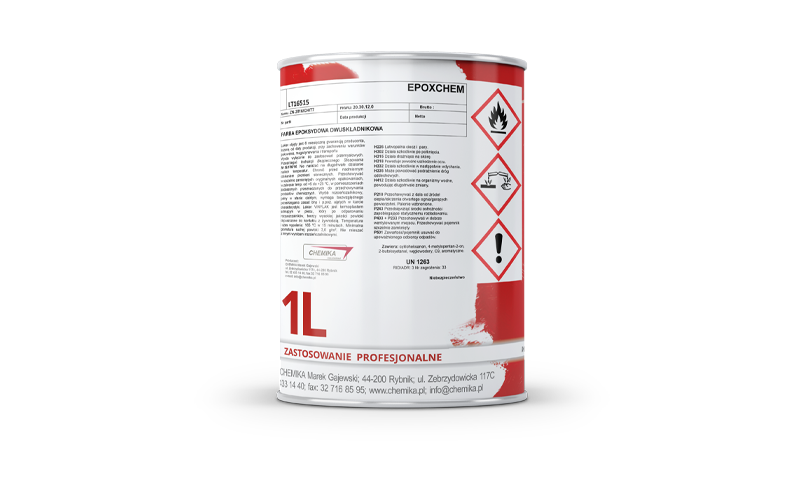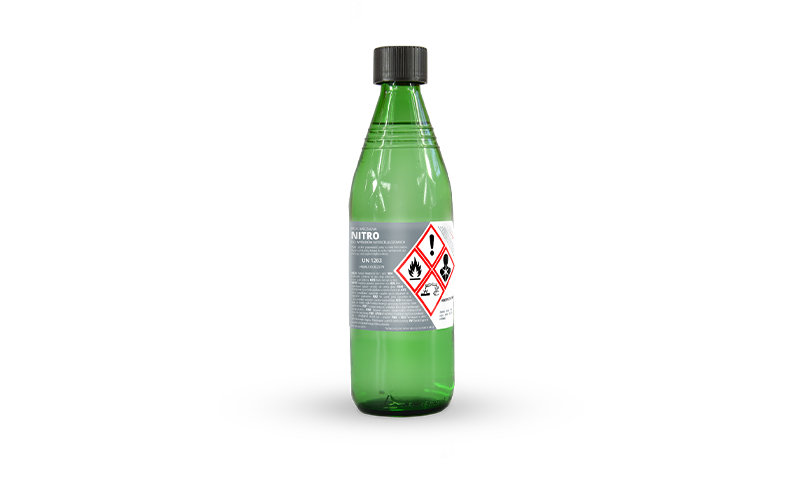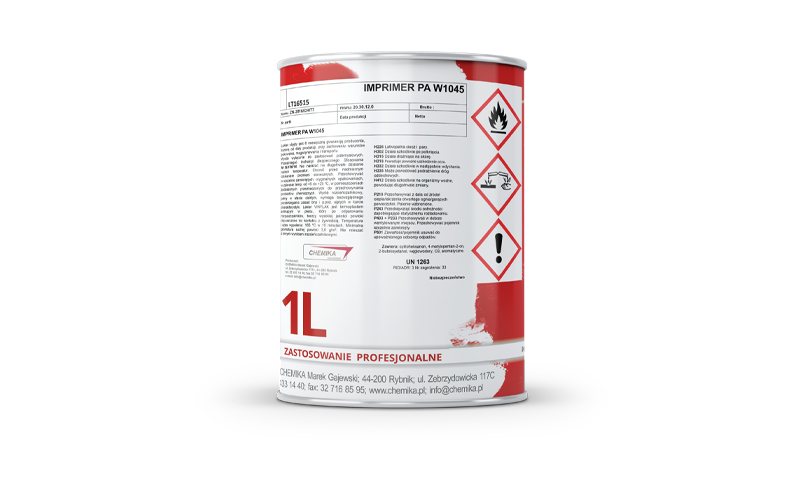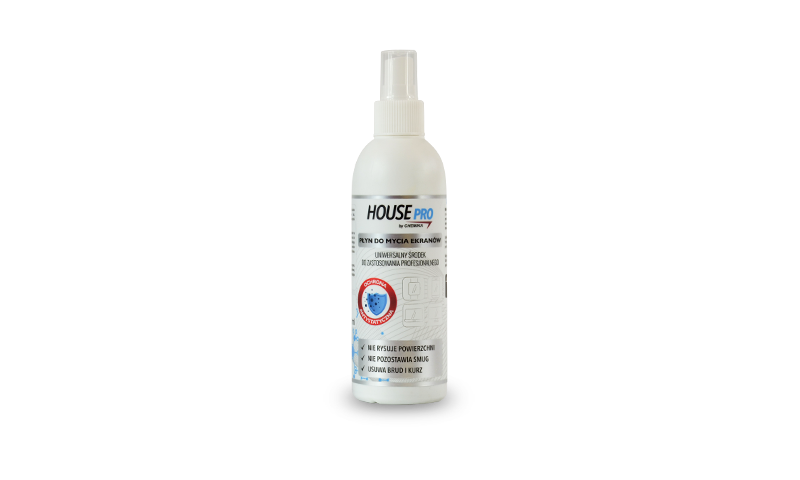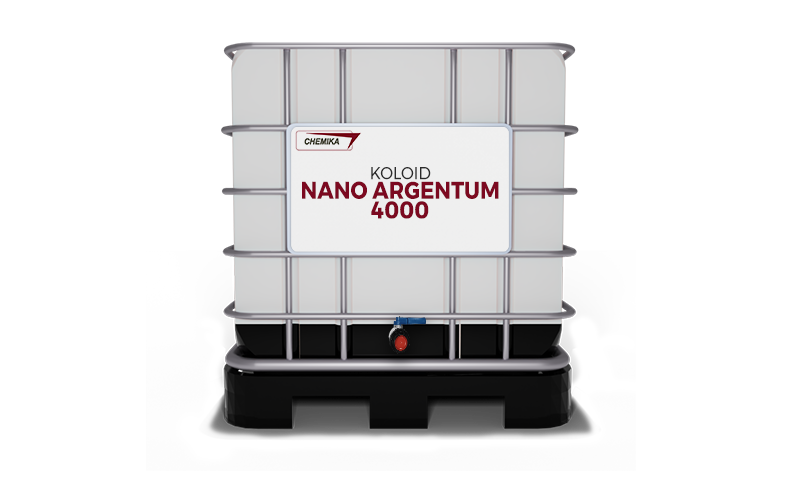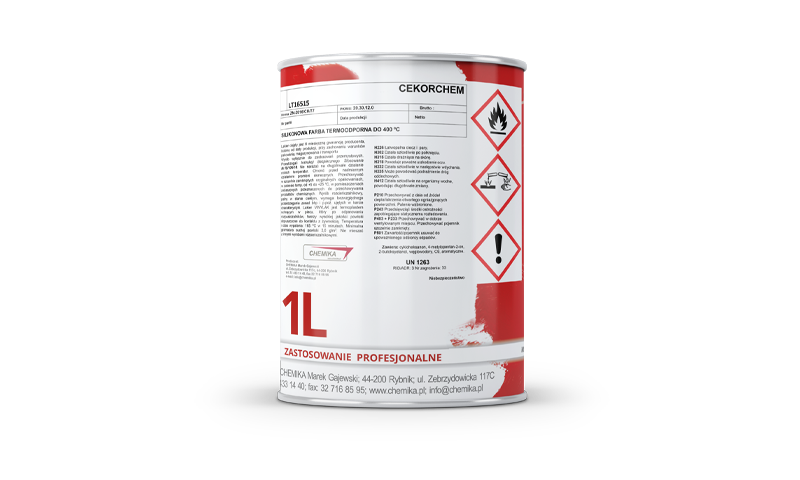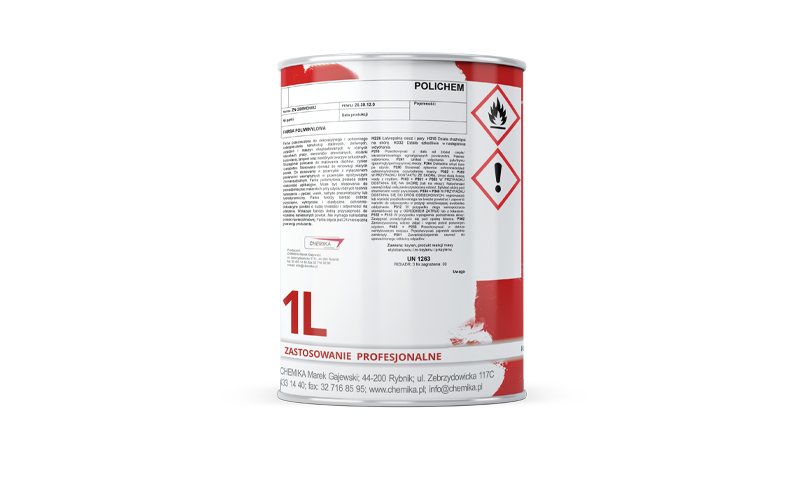Characteristics:
A suspension of pigments and fillers in a solution of epoxy resin in organic solvents, with the addition of auxiliary agents. EPOXCHEM is a two-component epoxy primer paint, based on a combination of epoxy resin and a hardener derived from dimerized fatty acids and polyamines.
Product Properties:
The EPOXCHEM primer paint exhibits excellent application properties. It can be used for painting with various application techniques—brush, roller, or spray. The paint forms highly adhesive, durable, and flexible protective coatings with high resistance to impacts and abrasion. It has excellent coverage and adhesion to previously applied coatings. The resulting coatings are smooth and resistant to changing weather conditions. High resistance to water, mineral and vegetable oils, greases, turpentine, kerosene, aliphatic petroleum derivatives, and, when top-coated, also to chemicals.
Purpose:
The paint is intended for use as a primer coating in epoxy coating systems under EPOXCHEM paints and enamels, as well as under PURCHEM polyurethane paints and enamels. It is designed to protect steel, cast iron, other metal elements, and certain plastics used in various working conditions. The paint is suitable for protective painting of equipment, machinery, and steel and iron structures, where high resistance, flexibility, and adhesion are particularly required. The paint can also be used for renovating old, well-adhering coatings without underlying corrosion. During renovation, old coatings should be thoroughly inspected. It is not necessary to remove coatings in good condition, but their adhesion should be assessed using methods such as cross-cut adhesion (PN-EN ISO 2409), pull-off tests (PN-EN 24624:1994), or other methods. Sub-coating corrosion is assessed by locally peeling off the coating and inspecting the exposed surface. Damaged coatings should be cleaned and primed with EPOXCHEM epoxy primer. Good condition coatings should be degreased, mattified, and dedusted before applying new paint. Properly prepared and cross-linked coatings enhance interlayer adhesion. Ionic contaminants are removed by washing the surface with pressurized water. Cleaning and degreasing can be done manually or mechanically using steam, water with detergent, organic solvents, emulsifying agents, and alkaline or acidic agents. Economical and ecological methods, such as spraying biodegradable detergent solutions, are particularly recommended. After washing with water-based cleaning agents, rinse the surface thoroughly with clean tap water. Degreasing with solvents may be done additionally after cleaning if grease is detected.
Application Method:
Before use, consult the safety data sheet for EPOXCHEM epoxy primer and hardener. The product is solvent-based and flammable, requiring strict adherence to health, safety, and fire protection regulations. Ensure sufficient quantities of component A (base) and component B (hardener) to prepare the working mixture in the exact ratio (5:1 by weight). Using an incorrect ratio will result in a mixture that cannot achieve the desired coating properties. Remove all contaminants from the substrate that might negatively affect the painting process. The surface must be clean and dry before painting. Clean steel surfaces to a Sa 2½ degree of cleanliness, removing rust and mill scale. Roughen zinc and aluminum surfaces. Surfaces that have exceeded the maximum interval for the next coat should also be roughened to improve adhesion. Prepare only the amount of paint that can be used within the pot life. Mix the components thoroughly in the entire container shortly before use, maintaining the correct ratio of base to hardener. Mechanical mixing with slow-speed hand mixers is recommended. Inadequate mixing or incorrect component ratios may result in poor curing and inferior coating properties. The mixture temperature should not be below 10°C, as lower temperatures significantly increase viscosity, hindering proper mixing and extending preparation time. Mix the paint well and dilute it with EPOXCHEM epoxy thinner, if needed, to achieve the required working viscosity for the chosen application method—brush, roller, pneumatic spray, or airless spray. Add thinner only after mixing the base and hardener. Avoid universal thinners, as they may contain ingredients that react with the hardener. Pot life depends on the working viscosity of the prepared mixture and the humidity and temperature conditions during application. The product's working time decreases as viscosity and temperature increase. EPOXCHEM hardener reacts with water and is sensitive to humid air; close hardener containers immediately after partial use. Moisture also adversely affects the mixed paint, so ensure the painted surface and compressed air used for spraying are completely dry. Apply paint to surfaces free of grease, dust, dirt, and moisture. The minimum temperature of the painted surface should not be below +5°C and at least 3°C above the dew point. Painting should be conducted at surface temperatures not exceeding 40°C. The maximum relative humidity during painting and drying should not exceed 80%.
For painting old coatings, check interlayer adhesion. If adhesion is class I, painting can proceed without sanding. For class II adhesion, sand the coating to improve adhesion and remove any dirt. For proper cross-linking, use sandpaper with a 220–320 grit. Coatings exceeding the maximum interval for the next coat also require thorough cross-linking.
The recommended dry film thickness is 45 ± 5 µm. Apply up to two coats. The wet film thickness should not exceed 125 µm. At the specified dry film thickness, the theoretical coverage is approximately 10 m²/L. Practical consumption depends on the application technique, surface type, spray losses, etc. Over-applying paint may alter its properties; it should not exceed twice the recommended film thickness. A thicker coat and increased humidity may slow the drying process.
The pot life of the prepared mixture depends on ambient temperature. At a working viscosity of 65–70 s (measured with a DIN 4 flow cup at 20°C and 65% relative humidity), the pot life is 24 hours. The maximum time for the next coat (wet-on-wet) and the minimum time (wet-on-dry) depend on the thickness of the applied coat, air humidity, and surface temperature. Clean spraying equipment and tools with thinner immediately after use.
Selected Technical Parameters:
| Density | Mixture (A + B) max. 1.40 g/cm³ | |||||||
| Viscosity (DIN 4 flow cup) |
|
|||||||
| Mixing Ratio by Weight | Base – 5 parts; Hardener – 1 part | |||||||
| Mixing Method | Low-speed mixer | |||||||
| Coverage Quality | Grade I – dark colors Grade II – light colors |
|||||||
| Gloss | Matte | |||||||
| Finish | Smooth | |||||||
| Color | Color palette | |||||||
| Thinning | After mixing base and hardener, use thinner for epoxy products | |||||||
| Cleaning Tools | Clean immediately after use with thinner | |||||||
| Volatile Content | 25% by weight | |||||||
| Recommended Dry Film Thickness | 40 ± 50 µm (per layer) | |||||||
| Recommended Wet Film Thickness | 100 ± 125 µm (per layer) | |||||||
| Theoretical Yield | 10 m²/L with a 40 µm dry layer | |||||||
| Adhesion | Grade I | |||||||
| Flexibility (PN-EN ISO 1519:2002) | Max. 4 mm | |||||||
| Hardness (PN-EN ISO 1522:2008) | 0.28 | |||||||
| Impact Resistance (PN-EN ISO 6272:2005) | 50 | |||||||
| Substrate Temperature | Not lower than 5°C, at least 3°C above dew point, max. 40°C |
|||||||
| Ambient Temperature | Not lower than 5°C (optimal above 10°C), max. 35°C | |||||||
| Mixture Temperature | Min. 10°C, Max. 35°C | |||||||
| Application Methods | Spray, brush, roller |
|||||||
| Recommended Number of Layers | 1÷2, depending on the desired thickness | |||||||
| Drying Time of Coating (at 20±2°C and relative humidity 55±5%) |
Stage I: 30 minutes Stage III: 3 hours Stage VI: 24 hours |
|||||||
| Time for Applying the Next Layer (at 20°C) |
Min. 3 hours for wet-on-wet method Min. 24 hours for wet-on-dry method |
|||||||
| VOC Content Limit (Category A/j/FR = 500 g/L) |
Stage II Max. 390 g/L | |||||||
| Tested parameters may vary with changes in environmental conditions, number, and thickness of layers. |
||||||||
| Applying a thicker coating layer or higher-than-recommended air humidity may slow down the drying process. | ||||||||
Factory Standard No. ZN-2011/CH/34.

